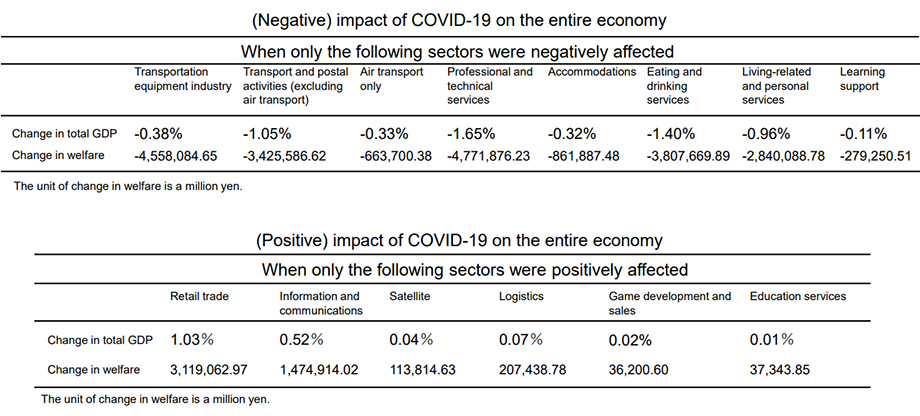COVID-19 decreased Japan’s total GDP by 4.21% and generated losses totaling almost 15.4 trillion yen
The impact of COVID-19 was calculated by embedding all relevant factors constituting the Japanese economy into the analysis model. The results showed that it decreased Japan’s total GDP by 4.21%. The welfare loss (the amount of decrease in total surplus such as taxation, regulations, and subsidies) rose to almost 15.4 trillion yen, and it is considered to have had a significant negative impact for the entire economy.
For this numerical analysis, a static general equilibrium model which reproduced the Japanese economy was used. First of all, I would like to explain what this is. Just like the old Japanese proverb “if the wind blows the barrel maker prospers,” an economy changes by a chain reaction. The general equilibrium is a method of analysis that takes all the relevant factors into consideration. However, it is too complicated to immediately start considering. Thus, firstly, we try to look at only the direct effects at the starting point. This is called partial equilibrium analysis.
For example, as you know, when the wheat price rises, wheat users and producers will be directly affected. Partial equilibrium analysis only focusses on such part. However, from that, we cannot tell the impact on the entire economy. Therefore, in the general equilibrium analysis, we think beyond that, for instance, the impact on the industry involved in dairy farming that uses wheat as feedstuff. Furthermore, if the income of the affected group decreases, the daily shopping list will also start to change. The general equilibrium analysis considers all the chains starting from the primary and leading to the secondary and the tertiary.
In addition, in the case of economics, it can be divided in statics and dynamics. Statics focusses on how the causal relation changes but does not follow the flow of time. It is a type of analysis, which makes comparisons, by, for example, looking at changes after a certain number of years since the implementation of a tax reform. On the other hand, a dynamic analysis tries to analyze the process of how the effect of the policy, such as putting off debt until the future when a government bond is issued, changes over time.
In economic analysis, a society is divided into two groups. The so-called consumer group, which uses goods and services, and the producer group, which offers them. The latter can be said to consist of companies. While a society is a chaotic and intricate group, from the perspective of money counting, it is considered to consist of these two groups. In both groups, by clearly distinguishing respective “things they want to do” from “things they can do” and as a result of them doing what they wanted to do the most within in their capabilities, we can rationally explain how the economy works.
We use the program to write an equilibrium state in the market where both consumer and producer groups meet, and calculate and analyze the movement of the entire economy. However, as long as we use a computer to make calculations, we need to specify the parameter value for the function. In order to reflect society as accurately as possible, aiming for nearly 100%, we set the parameter value based on the data from the latest version (2015) of the Input-Output Tables for Japan, which is issued every five years, and also by utilizing the data from the Annual Report on National Accounts.
2.7 trillion yen is the impact gained from Japan’s economic support measures investing as much as 25 trillion yen
Let us look into the results of the analysis in more detail. As you know, the coronavirus crisis affected the railway, airline, and accommodation industries. In particular, the airline industry suffered a significant blow of minus 72.0%. What the media did not pick up on so much and I myself did not expect was the impact on the transportation equipment industry due to the decrease of exports and imports. As the size of industry is large, it is considered that the GDP dropped by more than 4.5 trillion yen. Moreover, food and drink services dropped by 3.8 trillion yen, and living-related and entertainment industry dropped by 2.8 trillion yen.
Conversely, there were industries that showed positive changes. Staying-home demand pushed up the logistics related industry. Gaming equipment also showed high sales figures. Online services, including education, also showed increases. Overall, retailers prospered, and contributed a more-than-1%-increase to GDP.

I also analyzed the impact of government economic support measures. The government spent 25 trillion yen in total as economic support related to coronavirus, including support funds for small and mid-sized enterprises, a special cash payment of 100,000 yen per capita, etc. As a result, it increased the total GDP by 1.39%, and the positive effect is considered to be more than 2.7 trillion yen. It curtailed the GDP decrease rate to around 2.91% from 4.21%, which would have been the case if there had not been the series of economic measures. In other words, it is estimated that it managed to reduce the loss to a little less than 13 trillion yen from what was expected to rise to almost 15.4 trillion yen.
However, conversely, although it used as much as 25 trillion yen, the impact was only about 2.7 trillion yen. Honestly, I wonder whether there were not any better ways to use it. The invested 25 trillion yen plus the interest will be fully borne by future generations. As long as these financial resources are funded by government bonds, we also need to analyze the impact of burdening future generations with debt.
Numerical analysis based on objective data is needed to adopt the most beneficial policy
The Cabinet Office publishes mid- and long-term provisional calculations on economic and fiscal policy biannually. Although they also include quite an optimistic case in its future assumptions, Japan almost has not grown at all when we look at the economic growth rate of the past few decades. Compared to the U.S. and Europe, Japan is very much lagging behind in capital investment, and that has been pointed out multiple times by international organizations, such as the IMF (International Monetary Fund). In such a situation, some provisional calculations by the Cabinet Office, assuming that Japan will continue to achieve an almost 3% growth rate, are quite unrealistic.
In the first place, it is important to think about the economic support measures from a long-term perspective. What international economists, including us, are pointing out is that it is almost impossible to sustain the Japanese economy under the current policy. If it continues like this, we could face the same setback as Greece, which virtually went bankrupt as a result of its financial crisis.
Moreover, in Japanese society, where an extreme declining birthrate and aging is advancing, and the population is expected to halve within 100 years, it is unthinkable that its economy will grow stably. Unless there is remarkable technological innovation, it will be difficult to even maintain the status quo. When something happens, politicians immediately attempt to cover it by issuing government bonds. However, by now, we should be refraining from burdening future generations with debt while pretending that everything is fine as it is. Unless they reveal everything and considerably reduce public spending, the Japanese economy cannot survive.
To gain understanding from the public, and to make a correct policy decision, an approach showing evidence based on a logical thinking will be more important. We can say that economics is a study for that, and if it is not reflected in a real society, it is pointless. However, unfortunately in Japan, it is sometimes misunderstood as a fantasy of just using formulae, and economics is often not recognized correctly as it is in the U.S. and Europe. The mainstream of economic perspective is quite practical and meaningful. Policymakers should adopt a policy which brings the greatest benefit after deducting costs.
This does not only apply to countries but also to individuals. When you give a presentation at a corporation, while it is important to be passionate to appeal to others emotionally, we cannot convince them without giving logical explanations to support such passion. What are the grounds for it? Why is it beneficial? It is important to indicate what the best proposal is, after analyzing the current situation based on the most objective data available. When we propose something, the key is how precisely can we indicate what kind of benefits there are while costing how much with a number, by calculations based on objective data. In order to understand the current society and also aim for a better society, we can say that it is important to have an economic approach and perspective.
* The information contained herein is current as of February 2024.
* The contents of articles on Meiji.net are based on the personal ideas and opinions of the author and do not indicate the official opinion of Meiji University.
* I work to achieve SDGs related to the educational and research themes that I am currently engaged in.
Information noted in the articles and videos, such as positions and affiliations, are current at the time of production.


